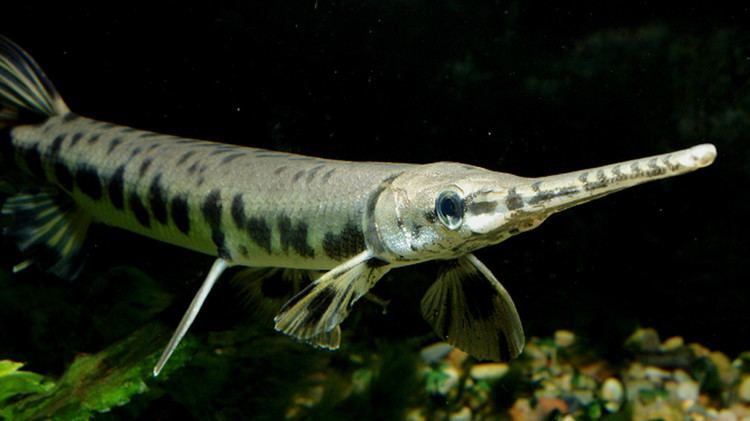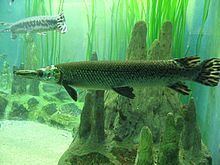Higher classification Lepisosteiformes Phylum Chordata | Scientific name Lepisosteidae Rank Family | |
 | ||
Order LepisosteiformesO. P. Hay, 1929 Lower classifications | ||
Gar fishing with artificial lures
Gars (or garpike) are members of the Lepisosteiformes (or Semionotiformes), an ancient holosteian order of ray-finned fish; fossils from this order are known from the late Cretaceous onwards. The family Lepisosteidae includes seven living species of fish in two genera that inhabit fresh, brackish, and occasionally marine, waters of eastern North America, Central America and the Caribbean islands. Gars have elongated bodies that are heavily armored with ganoid scales, and fronted by similarly elongated jaws filled with long, sharp teeth. All of the gars are relatively large fish, but the alligator gar (Atractosteus spatula) is the largest, as specimens have been reported to be 3 m (9.8 ft) in length; however, they typically grow to 2 m (6.6 ft) and weigh over 45.3 kg (100 lb). Unusually, their vascularised swim bladders can function as lungs, and most gars surface periodically to take a gulp of air. Gar flesh is edible and the hard skin and scales of gars are used by humans.
Contents
- Gar fishing with artificial lures
- Gar fishing in texas
- Etymology
- Distribution
- Anatomy and morphology
- Ecology
- Species
- Significance to humans
- References

Gar fishing in texas
Etymology

The name gar was originally used for a species of needlefish (Belone belone) found in the North Atlantic and likely taking its name from the Old English word for "spear". Belone belone is now more commonly referred to as the "garfish" or "gar fish" to avoid confusion with the North American gars of the family Lepisosteidae. Confusingly, the name "garfish" is commonly used for a number of other species of the related genera Strongylura, Tylosurus and Xenentodon of the family Belonidae.

The genus name Lepisosteus comes from the Greek lepis meaning "scale" and osteon meaning "bone". Atractosteus is similarly derived from Greek, in this case from atraktos, meaning arrow.
Distribution

Fossil gars are found in Europe, India, South America, and North America, indicating that in times past, these fish had a wider distribution than they do today. Gars are considered to be a remnant of a group of bony fish that flourished in the Mesozoic, and are most closely related to the bowfin.
Anatomy and morphology

Gar bodies are elongated, heavily armored with ganoid scales, and fronted by similarly elongated jaws filled with long, sharp teeth. Their tails are heterocercal, and the dorsal fins are close to the tail. As their vascularised swim bladders can function as lungs, most gars surface periodically to take a gulp of air, doing so more frequently in stagnant or warm water when the concentration of oxygen in the water is low. They also appear to surface in fast-moving rapids. As a result, they are extremely hardy and able to tolerate conditions that would kill most other fish.
All the gars are relatively large fish, but the alligator gar Atractosteus spatula is the largest. The largest alligator gar ever caught and officially recorded was 8 ft 5 1⁄4 in (2.572 m) long, weighed 327 lb (148 kg), and was 47 in (120 cm) around the girth. Even the smaller species, such as Lepisosteus oculatus, are large, commonly reaching lengths of over 60 cm (2.0 ft), and sometimes much more.
Ecology
Gars tend to be slow-moving fish except when striking at their prey. They prefer the shallow and weedy areas of rivers, lakes, and bayous, often congregating in small groups. They are voracious predators, catching their prey with their needle-like teeth, obtained with a sideways strike of the head. They feed extensively on smaller fish and invertebrates such as crabs. Gars are found across all of North America (for example Lepisosteus osseus). Although gars are primarily found in freshwater habitats, several species enter brackish waters and a few, most notably Atractosteus tristoechus, are sometimes found in the sea. Some gars travel from lakes and rivers through sewers to get to ponds.
Species
The gar family contains seven extant species, in two genera:
Family Lepisosteidae
Significance to humans
Gar flesh is edible, and sometimes available in markets, but unlike the sturgeon they resemble, their eggs are highly toxic to humans. Several species are traded as aquarium fish.
The hard skin and scales of the gar were used by humans. Native Americans used the scales of the gar as arrowheads, native Caribbeans used the skin for breastplates, and early American pioneers covered the blades of their plows in gar skin. Not much is known about the precise function of the gar in Native American religion and culture, but besides using the gar, Creek and Chickasaw people have ritual "garfish dances".
